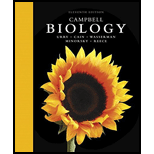
Concept explainers
Considering the second law of
To examine: Whether the primary producers or the secondary producers would have greater or lesser biomass production in an ecosystem, considering the 2nd law of thermodynamics.
Introduction: The second law of thermodynamics states that “no energy transfer is 100% efficient; some energy is dispersed as heat”. In a living system such as in a cell, the second law of thermodynamics states that the capture and storage or use of energy is never 100% by the living cells. The energy is lost as disordered and metabolic heat energy.
Explanation of Solution
As per the 2nd law of thermodynamics, the useable energy decreases all the time. Only 10% of the original energy is useable for the successive trophic level, whereas 90% is lost in the form of heat. When the secondary producers or the primary consumers eat a primary producer (grass or plants), it is not all of the energy that is stored in the plant gets converted to useable energy. This is because during energy transfer, the energy is always lost due to entropy.
Therefore, it suggests that for maintaining its life functions, an organism must use much energy. The lost energy in the form of heat by an organism is no longer useable for them as well as for other organisms.
In the case of secondary producers, the biomass will always be less when compared to the primary producers because of 10% rule, and the successive energy transfer will always be less than that of the primary producers.
The typical biomass of the primary producers will always be greater than that of the secondary producers.
Want to see more full solutions like this?
Chapter 55 Solutions
Campbell Biology Plus Mastering Biology with Pearson eText - Access Card Package (11th Edition)
Additional Science Textbook Solutions
Genetic Analysis: An Integrated Approach (3rd Edition)
Physics for Scientists and Engineers: A Strategic Approach, Vol. 1 (Chs 1-21) (4th Edition)
Human Anatomy & Physiology (2nd Edition)
Biology: Life on Earth (11th Edition)
Human Biology: Concepts and Current Issues (8th Edition)
Introductory Chemistry (6th Edition)
- Not part of a graded assignment, from a past midtermarrow_forwardNoggin mutation: The mouse, one of the phenotypic consequences of Noggin mutationis mispatterning of the spinal cord, in the posterior region of the mouse embryo, suchthat in the hindlimb region the more ventral fates are lost, and the dorsal Pax3 domain isexpanded. (this experiment is not in the lectures).a. Hypothesis for why: What would be your hypothesis for why the ventral fatesare lost and dorsal fates expanded? Include in your answer the words notochord,BMP, SHH and either (or both of) surface ectoderm or lateral plate mesodermarrow_forwardNot part of a graded assignment, from a past midtermarrow_forward
- Explain in a flowcharts organazing the words down below: genetics Chromosomes Inheritance DNA & Genes Mutations Proteinsarrow_forwardplease helparrow_forwardWhat does the heavy dark line along collecting duct tell us about water reabsorption in this individual at this time? What does the heavy dark line along collecting duct tell us about ADH secretion in this individual at this time?arrow_forward
 Biology (MindTap Course List)BiologyISBN:9781337392938Author:Eldra Solomon, Charles Martin, Diana W. Martin, Linda R. BergPublisher:Cengage Learning
Biology (MindTap Course List)BiologyISBN:9781337392938Author:Eldra Solomon, Charles Martin, Diana W. Martin, Linda R. BergPublisher:Cengage Learning Human Biology (MindTap Course List)BiologyISBN:9781305112100Author:Cecie Starr, Beverly McMillanPublisher:Cengage Learning
Human Biology (MindTap Course List)BiologyISBN:9781305112100Author:Cecie Starr, Beverly McMillanPublisher:Cengage Learning Concepts of BiologyBiologyISBN:9781938168116Author:Samantha Fowler, Rebecca Roush, James WisePublisher:OpenStax College
Concepts of BiologyBiologyISBN:9781938168116Author:Samantha Fowler, Rebecca Roush, James WisePublisher:OpenStax College Biology: The Dynamic Science (MindTap Course List)BiologyISBN:9781305389892Author:Peter J. Russell, Paul E. Hertz, Beverly McMillanPublisher:Cengage Learning
Biology: The Dynamic Science (MindTap Course List)BiologyISBN:9781305389892Author:Peter J. Russell, Paul E. Hertz, Beverly McMillanPublisher:Cengage Learning





